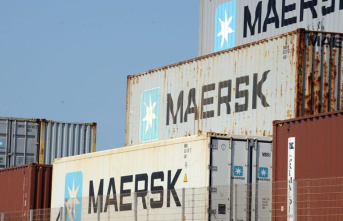After a weak July, German exports are picking up again. Exports increased by 1.6 percent in August compared to the previous month, as the Federal Statistical Office announced on Wednesday.
Goods worth 133.1 billion euros were delivered, which was an increase of 18.1 percent compared to August 2021. According to the assessment of the foreign trade association BGA, foreign trade is defying the crisis. However, high energy prices, problems in the supply chains and the slowdown in the global economy are weighing on the outlook.
A minus in the third quarter is becoming apparent
"The slight growth in exports in August is just a last flare-up before a cold export winter," said Volker Treier from the German Chamber of Industry and Commerce (DIHK). German exporters are forced to pass on their cost increases to customers. The DIHK foreign trade chief reported that this was only partially successful. The energy price increases, which were particularly pronounced in Germany, were at the expense of international competitiveness. "Overall, there are already signs of a minus in foreign trade for the third quarter."
Exports in August were mainly boosted by business with the USA. Companies from Germany exported 12.0 percent more goods to the world's largest economy than in July. According to economists, the weak euro also plays a role. Calculated in dollars, products from Germany are therefore cheaper in the USA. The country is the most important single market for goods "Made in Germany". Exports to the equally important Chinese market rose by 2.9 percent to 9.2 billion euros.
The USA is becoming more and more important as an export partner for Germany, especially in uncertain times, said Dirk Jandura, President of the Federal Association of Wholesale, Foreign Trade and Services (BGA). "We now need fast progress in the negotiations within the framework of the Trade and Technology Council TTC. This is a great opportunity to avoid trade conflicts in the future."
The data from the Wiesbaden authority does not show what role price increases play. No price-adjusted information is provided. Theoretically, higher prices could also increase the value of exports.
The prospects remain mixed
Thomas Gitzel, chief economist at VP Bank, described the increase in exports as positive overall. "It gives hope that German exporters got off with a black eye again in the third quarter." However, the economic prospects for the global economy became increasingly gloomy. "The German economy, with its strong export industry, is particularly exposed to the global economic adversities," said Gitzel. It can be assumed that the export business will dampen economic growth.
According to the Ifo Institute, export expectations for the German economy fell in September to their lowest level since May 2020.
"Even if transport costs have started to fall and global supply chains have relaxed somewhat, the prospects for the German export industry remain mixed at best," said ING chief economist Carsten Brzeski.
From January up to and including August, German exports totaled 1024.9 billion euros. Despite the upheavals resulting from the Ukraine war, this is an increase of 14.3 percent compared to the same period last year.
Imports to Germany grew even faster than exports in August. They rose by 3.4 percent compared to the previous month. Within a year, imports increased by 33.3 percent to 131.9 billion euros. The price increase for oil and gas also plays a role. Germany is dependent on energy imports from abroad.







